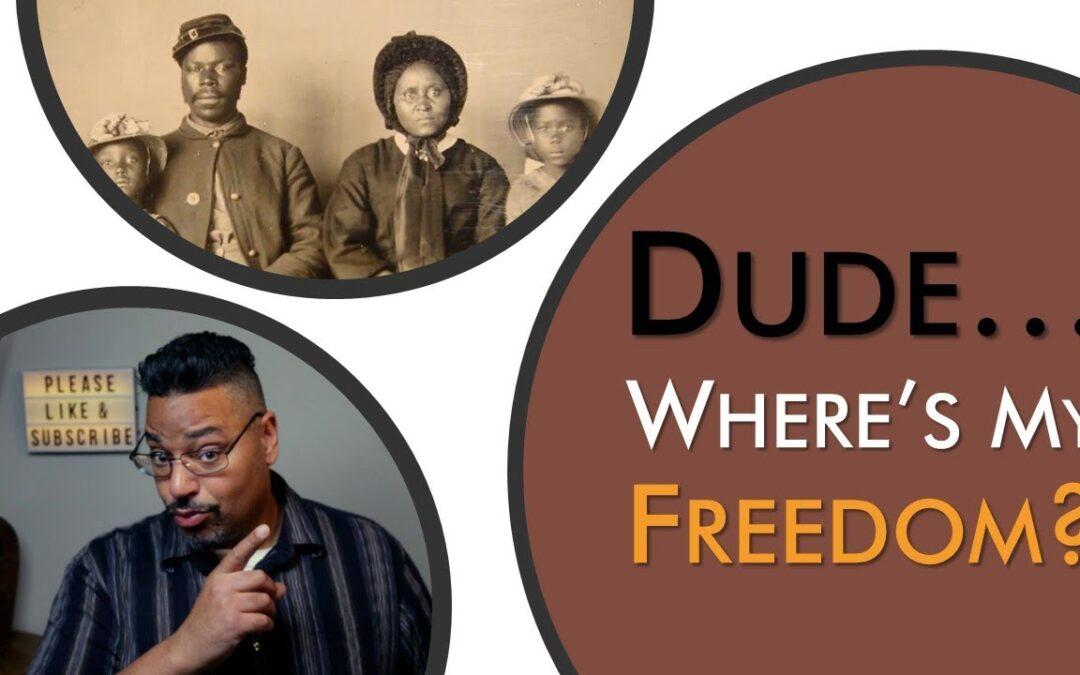3 Ways The Civil War Failed to End Slavery… And 4 Things Black People Did about It
FOLLOWED BY LIVE Q&A
Thursday, April 15, 2021 @ 6:30pm
(Click here immediately after the premier for live Q&A)
Convict leasing, sharecropping, and domestic service are some of the ways that newly emancipated Blacks continued to face involuntary servitude after the Civil War. But Black people rose to the challenge. In this episode we discuss three ways the Civil War failed to end slavery AND four things Black people did about.
This presentation contains images that were used under a Creative Commons License. Click here to see the full list of images and attributions:
https://link.attribute.to/cc/2099448
SOURCES:
1. Davis, A.Y. Women, Race, & Class: Knopf Doubleday Publishing Group, 2011.
2. Oshinsky, David M. Worse Than Slavery: Parchman Farm and the Ordeal of Jim Crow Justice. New York: Free Press, 1996. Print.
3. Spearman, Darius. Between the Color Lines: A History of African Americans on the California Frontier from 1769 to 1890. Dubuque, Iowa Kendall Hunt Publishing Co., 1st ed.
I’m Darius Spearman, and you’re watching African Elements. Convict leasing, sharecropping, and domestic service. These are some of the ways that newly emancipated Blacks continued to face involuntary servitude after the Civil War. But Black people rose to the challenge. In this episode we discuss three ways the Civil War failed to end slavery and four things Black people did about. All that, coming up next…
[expand title=”CLICK HERE FOR TRANSCRIPT”]
Thank you for watching African Elements. If you’re new to this channel, we produce content in Black and Africana Studies and make it accessible to the masses. For more news, videos, and educational material, visit our website at africanelements.org.
Thanks again to our Patreon members for your support. If you’d like to join them for as little as a dollar a month, click the link in the description. Otherwise, you can also help us out by dropping a “like” and subscribing. That said, let’s start by discussing 3 ways the Civil War failed to end slavery.
1. The 13th Amendment & Criminalization
First, with the end of the Civil War in 1865, Black Americans experienced a glimmer of hope in what are commonly called “The Reconstruction Amendments.” These are the 13th, 14th, and 15th amendments to the United States constitution.
The 13th amendment stated in part that “Neither slavery nor involuntary servitude shall exist in the United States…” Significantly, though, it goes on to qualify “… except as punishment for a crime.” Notably here, the 13th amendment explicitly provides for the continuance of slavery “as punishment for a crime.” So right from jump, slavery isn’t outright abolished by the 13th amendment.
A set of laws commonly referred to as “black codes” combined with convict leasing ensured that former slaves were kept in perpetual criminal status and subjected to involuntary servitude as permitted by the 13th amendment.
As the confederate states rejoined the union they were required to redraft their state constitutions acknowledging the 13th Amendment, but beginning with Mississippi, the former confederate states also included an additional set of laws directed specifically at Blacks intended to strip them of any semblance of equal protection.
Under the “black codes” Blacks who couldn’t prove that they were under the employment of whites were regularly charged with vagrancy and imprisoned. In addition, freedmen and women were routinely arrested for such vaguely defined offenses as “mischief.”
As Mississippi jails began to fill with former slaves, Mississippi State Penitentiary’s Parchman Farm paved the way for the convict lease system. Just a few years after the Civil War, the state legislature passed an act allowing prisoners to be put to work outside the penitentiary building railroads and levees, or they could out to leased out to private interests.
While the act didn’t specify which prisoners would be put to work outside the penitentiary, a penitentiary report of 1871 makes it clear that convict labor was exclusive to Black inmates. According to the report “’146 colored males’ and ‘6 colored females were shipped to the [Yazoo] Delta, while ’61 white males’ and ’25 colored males’ (the old and disabled) remained at the state penitentiary…” (Oshinsky 36)
Flying in the face of the 14th amendment, which ostensibly ensured equal protection under the law, by the end of Reconstruction, Southern Blacks were shackled within a separate and unequal justice system specifically concocted to keep them in a perpetual slave-like condition.
2. Sharecropping
Second, aside from the explicit ways that the 13th amendment allowed the continuation of involuntary servitude, one of the labor systems that emerged in the Reconstruction era was sharecropping. As sharecroppers, former slaves worked a parcel of land in exchange for a share of the profits often for their former slave owners on the very plantations where they had been enslaved.
In theory, these freed men and women were paid for their labor, but in practice sharecroppers were heavily exploited. They were usually required to sell the cotton they had harvested directly to the plantation owner at whatever price the he set. Additionally, sharecroppers were required to purchase seeds, tools, and provisions from the plantation owner – again with the plantation owner setting the price. Since sharecroppers only saw money once a year (at harvest), plantation owners who controlled both sides of the ledger had the ability to ensure that the sharecropper’s share didn’t cover the debts they had incurred, and after a year’s worth of hard labor, sharecropping families often found themselves in debt. That meant they were bound to service to the plantation owner for an additional year to pay off the artificially contrived debt. The result was a revolving door of debt peonage that bound families of freed men and women to sharecropping plantations until well into the mid-20th century. So, even for free men and women who hadn’t committed a crime, sharecropping was a form of involuntary servitude that persisted for generations.
3. Domestic Service
Third, as Angela Davis writes in her book, Women Race & Class, Black women were subject to arrest and convict lease as well as Black men, but just as Black women experienced slavery and sexual exploitation in ways that Black men were biologically incapable, Black women endured the hardships of emancipation in ways specific to their gender as well. For Black women, exploitative labor contracts included not just sharecropping, but for most, their only real alternative was work as domestic servants. That meant that Black women were on duty 24 hours a day, seven days a week and often compensated only with room and board. As Angela Davis points out, “emancipated” Black women who were laboring as domestic servants inside white homes were also vulnerable to sexual assault just as they had been in slavery.
If there was any question as to whether the Civil War was fought for the purpose of liberating Blacks, Abraham Lincoln himself made it explicitly clear on numerous occasions that Black liberation was not his objective. Even after the Emancipation Proclamation, Lincoln himself spoke directly to Black people on how he envisioned their “freedom.”
“You are now free; but yours is a limited, crippled, inferior Negro freedom at best, and there is little prospect of its improvement here. You are disliked and regarded with prejudice by whites… So you ought to migrate to Central America where you shall have new homes… I strongly urge you to go.” (Spearman 123-124).
How did Blacks respond?
1. Proclaiming Their Own Freedom
First, in response to Lincoln’s proclamation of limited, crippled, and inferior emancipation, Black folks made their own proclamations of freedom. One Black San Franciscan boldly proclaimed,
“The colored American has exhibited all the necessary qualifications for citizenship in a greater degree than many that might have been naturalized; and when the rebellion shall have been crushed, we are sanguine that, in the new order of the affairs of the nation that will follow, the claims of the colored American will be viewed in a different light than heretofore, and that he will be considered a part of those who have ever toiled and contributed to make the nation great and glorious, free and independent.” (Spearman 125)
2. Fundraising
Second, Blacks liberated by the Emancipation Proclamation (often referred to as “contrabands”) were landless, poor, and destitute leaving them vulnerable to black codes which targeted them for vagrancy. In response, Black people raised funds to support them. 50 miles north of San Francisco in Sonoma County California, a series of events was held to raise “contributions for the relief of starving contrabands.” In Santa Rosa, $19 was raised and in Petaluma, $123.50 was raised. (Spearman 127)
3 & 4. Land and employment
As many freed men and women were left landless and homeless, many more well-off Blacks used their resources to purchase land and set up businesses to both house and support them. Mary Ellen Pleasant, a powerful and wealthy Black San Franciscan, set up several businesses that put some 50 people to work and also financed several former slaves to set up businesses of their own. (Spearman 127)
Also in California, John Richards of Santa Rosa employed Black barbers at three shops he owned in Santa Rosa, Lakeport, and Ukiah. He also owned 130 acres of land in Santa Rosa where he provided refuge for former slaves. (Spearman 121)
So as we have seen, the 13th Amendment of the constitution explicitly maintained slavery by allowing involuntary servitude to continue in the form of black codes and the convict lease system. Additionally, slavery was simply replaced by other forms of involuntary servitude such as sharecropping, and domestic service. But we’ve also seen just a few examples of some of the many ways Black folks responded by proclaiming their own freedom, raising money to secure that freedom, acquiring land for themselves as well as their newly emancipated brothers and sisters, and by providing their own means to secure a living.
What are some strategies you might use to ensure meaningful freedom for those who are to this day under the control of the state? Let’s have that discussion in the comments below.
I’m Darius Spearman. Thank you for watching, and until next time, I’ll see you in the comments.[/expand]

